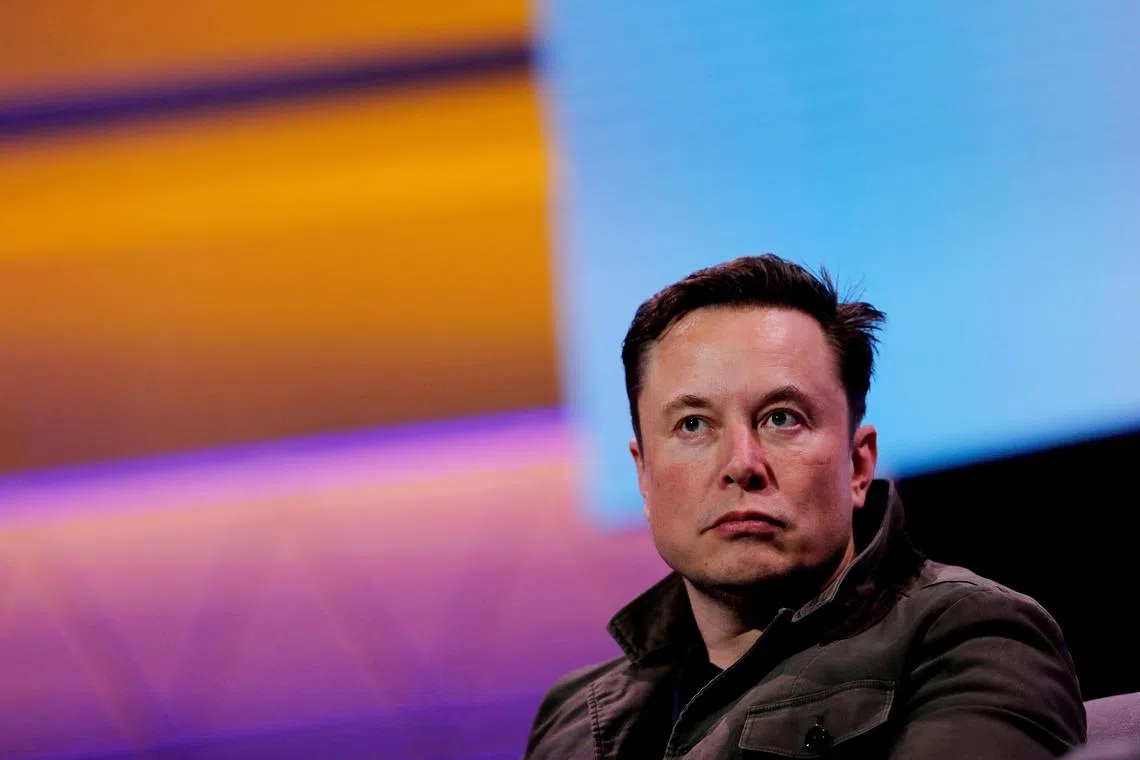Elon Musk is doing to Twitter what he did at Tesla and SpaceX
Sign up now: Get ST's newsletters delivered to your inbox

Mr Elon Musk’s all-in commitment to a company is often inspirational, but can also turn toxic.
PHOTO: REUTERS
Follow topic:
Los Angeles – Mr Elon Musk was sleeping at the office. He dismissed employees and executives at will. And he lamented that his company was on the verge of bankruptcy.
That was back in 2018 and the company was Tesla, as Mr Musk’s electric-car maker struggled to build its mass market vehicle, the Model 3.
The billionaire’s experience with what he called Tesla’s “production hell” has become a blueprint for the crisis he has created at Twitter, which he bought for US$44 billion (S$60.8 billion) last month. Over the years, Mr Musk has developed a playbook for managing his companies – including Tesla and rocket manufacturer SpaceX – through periods of pain, employing shock treatment and alarmism and pushing his workers and himself to put aside their families and friends to spend all their energy on his mission.
At Twitter, Mr Musk has used many of those same tactics to upend the social media company in just a few weeks.
Since late last month, the 51-year-old has laid off 50 per cent of Twitter’s 7,500 employees
Mr David Deak, who worked at Tesla from 2014 to 2016 as a senior engineering manager overseeing a supply chain for battery materials, said Mr Musk “clearly thrives in existential circumstances”.
“He quasi-creates them to light the fire under everybody,” he added.
At companies led by Mr Musk, the pattern of claiming that the firms are on the brink of a potential bankruptcy has come up often. At Tesla in December 2008, during the depths of the financial crisis, Mr Musk closed a US$50 million investment round from Daimler, he said, on the “last hour of last day possible or payroll would’ve bounced two days later”.
He has said the same about SpaceX, once noting that both SpaceX and Tesla had a more than 90 per cent chance that they “would be worth $0” in their early days.
A crisis atmosphere and self-imposed austerity give Mr Musk the cover to make drastic changes and fire top managers or eliminate large swathes of staff, two former Tesla executives said. It also prepares those who remain to work under extreme conditions to bring about Mr Musk’s desires, they said.
The approach at Twitter, where Mr Musk has laid off thousands of employees, “is typical Elon”, Mr Deak said.
The chaos at the social media company is familiar to people who worked at Tesla when the company was struggling to ramp up manufacturing of the Model 3, which went on sale in 2017. In May of that year, Mr Musk sent an e-mail to staff that echoed some of the language he has used with Twitter employees.
“Tesla has to be hardcore and demanding,” he wrote. “The passing grade at Tesla is excellence, because it has to be.”
In the year that followed, Mr Musk famously slept on the floor in a Tesla factory’s conference rooms, fired the vice-president of engineering and worked 120-hour weeks to cope with a lag in the production of Model 3s. Members of Tesla’s board worried about Mr Musk’s workload and his use of medicine to try to sleep.
Some of Mr Musk’s former employees question whether his management tactics will ultimately work at Twitter. Tesla and SpaceX were in earlier stages of growth when their boss whipped out his tough language and told everyone they had to go full tilt. But Twitter is a more mature company that has performed inconsistently for years.
Mr Musk’s management technique is “good start-up and growth strategy, but it is not good for building a stable company”, Mr Deak said.
Mr Musk’s all-in commitment to a company is often inspirational, but can also turn toxic and engender a culture of fear and scapegoating, three former Tesla and SpaceX managers said.
The similarities between Mr Musk’s approach to Twitter and what he did at Tesla and SpaceX are evident, said Santa Clara University management professor Tammy Madsen. But it is unclear if he will find the means to motivate employees at a social media company as he did with workers whose quests were to move people away from petrol-powered cars or send humans into space.
“At Tesla and SpaceX, the approach has always been high risk, high reward,” Prof Madsen said. “Twitter has been high risk, but the question is: What is the reward that comes out of it?” NYTimes

